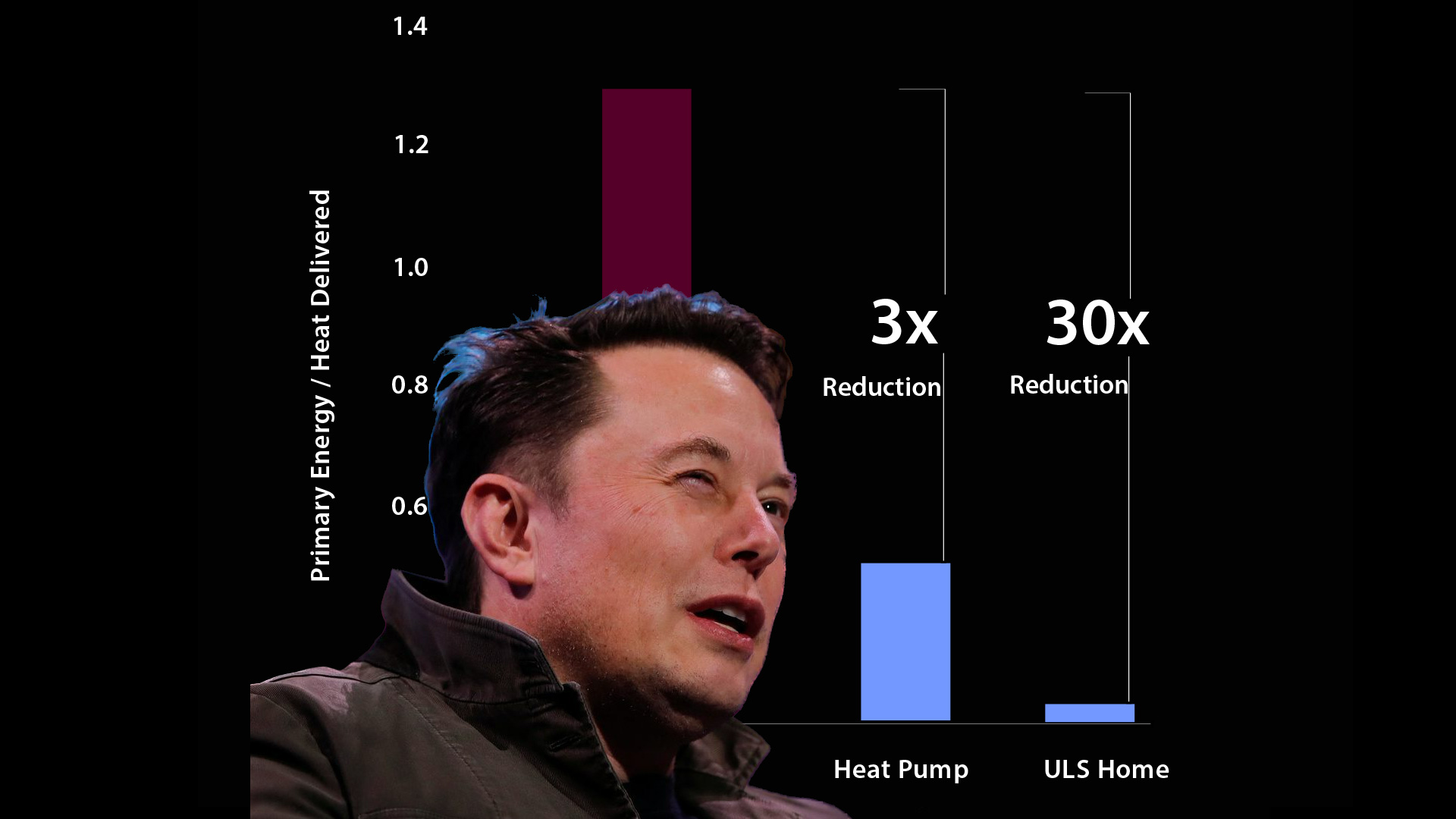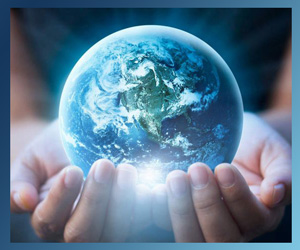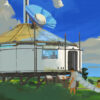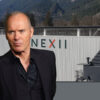Design architecture is not just for cars
Elon Musk & Tesla made headlines, again, on Wednesday, with an Investor Day presentation outlining “Master Plan 3”.
The introductory kick-off was an overview and update focused on the Tesla mission, now expanded from the original (now outdated )“to accelerate the world’s transition to sustainable transport” to “We’re building a world powered by solar energy, running on batteries and transported by electric vehicles” (I’ve skipped over some interim mission statements for dramatic effect).
The facts and figures presented in the intro were compelling, optimistic and almost certainly true.
At one point, during the intro to the car and manufacturing portion of the presentation, the importance of design architecture was stressed.
Naturally this was in relation to EV design plus car manufacturing systems design, and, for obvious reasons, actual architecture, for buildings and homes, was not mentioned.

In the “macro” introduction section of the show, a plan was put forth on how we should transition the world to a sustainable electrified system, and away from the combustion economy of today.

Since the “built-world” represents, by many estimates, around 40% of GHG emissions (of course nearly all traceable back to the “combustion economy”) while transportation weighs in at 27% (epa estimate for US) some solution for buildings would, naturally, have to be included.
In an apparent effort to simplify a maddeningly complex issue, “switch to heat pumps” was selected as the “solution” for the entire sector.

Heat pumps are huge, particularly for retrofit, but what about new built homes and buildings?
As a carmaker that also produces batteries for homes plus grid storage and solar PV home systems, it’s understandable that a presentation for shareholders would not go into a lot of detail regarding products not part of the Tesla line up.
Presenting a global vision and mentioning design architecture for cars and factories but nothing regarding the sleeping giant of increased energy efficiency in architecture for actual homes and buildings is more than a little short sighted.
Even in a brief presentation like this, implying that the only upgrade needed to the entire built world infrastructure is to “switch to heat pumps” misses perhaps the greatest area of potential sustainable energy development of all: creating new buildings to take the most advantage possible of new technologies such as heat pumps, PV micro-grids, battery back up and load management, virtual power plants, net metering and more.
How? By designing the most energy efficient home or building possible in the first place.
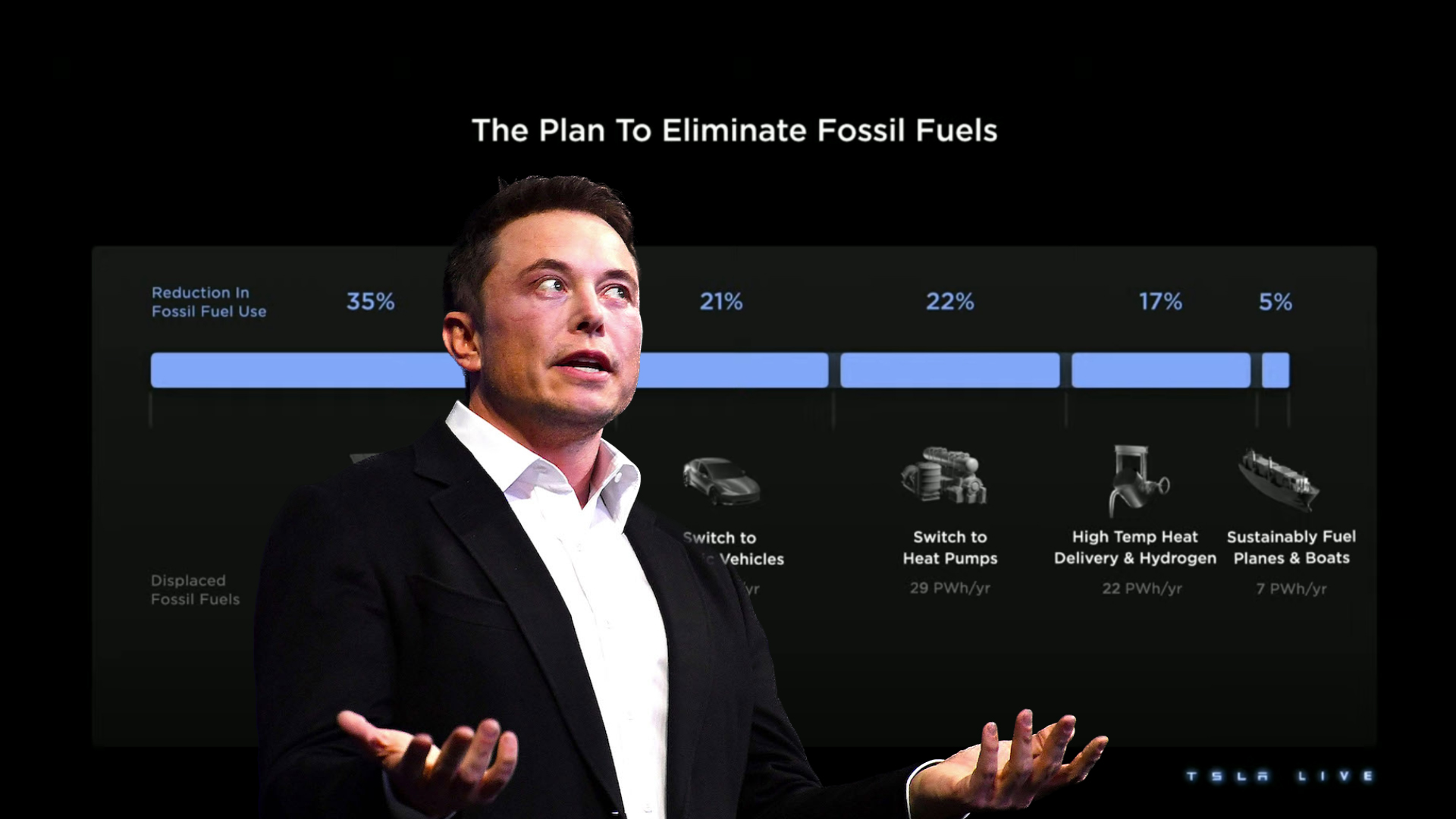
Build the whole house, knucklehead!
Energy efficient design is not a product, per se. As such there is little incentive to champion its power for positive change at a shareholder presentation.
Obviously, Elon Musk is not a simpleton or knucklehead. But with great power comes great responsibility, as they say. And it’s irresponsible to put forth a plan for eliminating fossil fuels and overlook this immense opportunity.
Make no mistake, the combination of 90% more energy efficient architectural design and “right sized” (in other words tiny) appliances like heat pumps, when applied to new construction at scale, could magnify the impact on reducing fossil fuel usage and dependance by a massive amount.
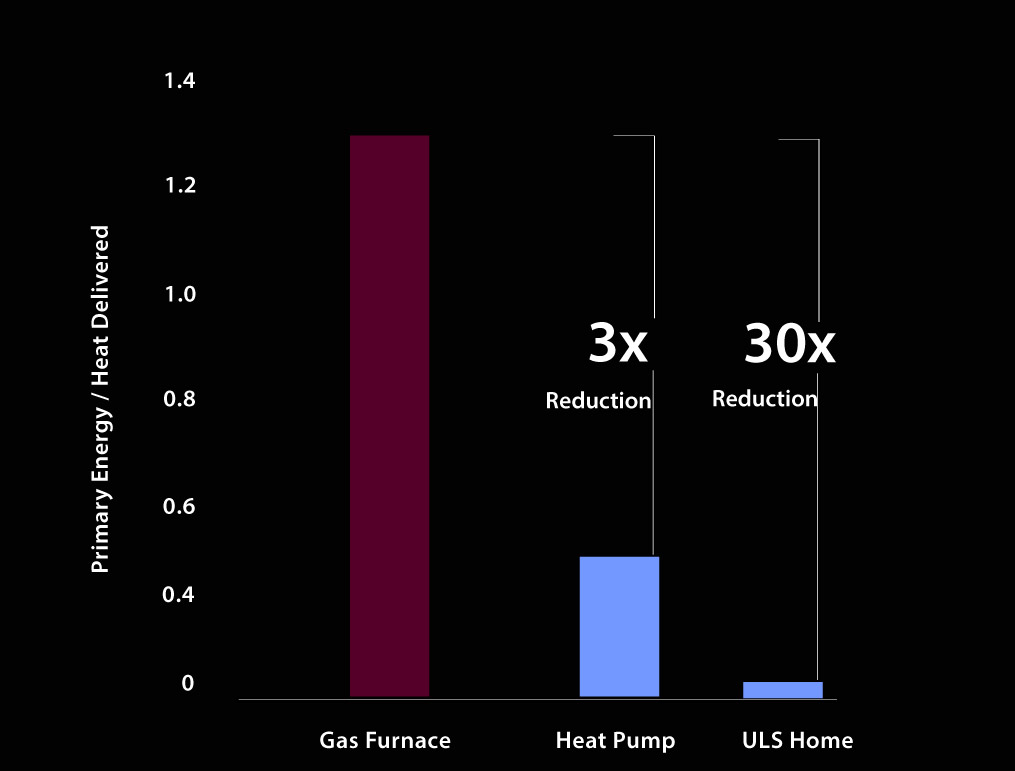
The chart above, the same calculation made by Tesla, shows that taking an existing low performance building and replacing its gas furnace with a heat pump would reduce “primary energy” required by 3x.
Meanwhile, a new building designed to meet a 90% performance (Ultimate Living System) standard, with the same heat pump, would result in a 30x reduction!
Proposing a 3x solution in this scenario is like vowing to empty a lake with a teaspoon (while adoring fans cheer) even as a 1 gallon scoop lays at your feet.
As is, sadly, so often the case, the idea that hyper-efficient design principles are critically important for things like electric cars, ships, aircraft and so on, but are not worth mentioning with relation to buildings and architecture, is accepted without question during the Tesla “Master Plan 3” presentation.
Retrofit uses for heat pumps are a great idea, no doubt there…
But the idea that heat pumps alone will solve the enormous and critical problems that are present in the built world is a massive understatement, at best.
Here’s how it was looking back (slight progress has occurred) but, seriously, can heat pumps alone, even slick beautiful ones, put a dent in this?:
Real Estate is the largest asset class on earth, representing…
- 13% of U.S. GDP
- $11 trillion annual output
- $42 trillion in U.S. capital markets
- $326 trillion in global capital markets
- $23 trillion in lending capital
…and also the largest emitter of GHGs, responsible for…
- 40% of global energy use
- 40% of global CO2 emissions
- 40% of raw materials consumption
A clear path to a fully sustainable earth, with abundance
Just as Elon Musk pointed out that fully two thirds of fossil fuel energy burned brings no benefit, and that there is a “clear path to a fully sustainable earth with abundance”, slapping heat pumps on to existing ultra low performance buildings and even continuing to build nonsense structures to do it some more, is not a viable or intelligent solution for new built structures (single family homes starts in the US alone were around 1 million in 2021).
Not taking the opportunity to remove the misapplied link between “efficiency” and austerity was also unfortunate.
To calculate that an internal combustion engine based car “is converting less than a third, often only 25%, of the energy in the gasoline is converted into motion, the rest is turned into waste heat” is wonderful, but then implying that taking a low performance building and adding heat pumps to it is sufficient to solve the problems of the built world as a contributor to global warming misses a great opportunity.
”converting less than a third…, often only 25%, of the energy in the gasoline is converted into motion, the rest is turned into waste heat”
– Elon Musk
This confusion is extended to many by wishing away the need for more efficient architectural design by saying we just need a sustainable grid for an all electric society, and not addressing, even for a second, the problems that it overlooks.
Picture a large building, or, for example, a million single family homes.
Currently the system of heating, cooling and sending electricity to them is on the verge of collapse, in many places, and to a great degree it’s because the wasted energy of those million homes is a nightmare far uglier than the illustration used describing the ICE car above.
While doing nothing about the energy efficiency of the structures themselves and just swapping out a typical legacy HVAC system for a heat pump will bring a 3x reduction in the total energy required to heat or cool a building, that’s the least important part of the story.
What would that number be if the same comparison were made with a hyper-efficient building with a heat pump being compared to the business as usual case? A 30x reduction.
Try multiplying that by every structure on the planet!
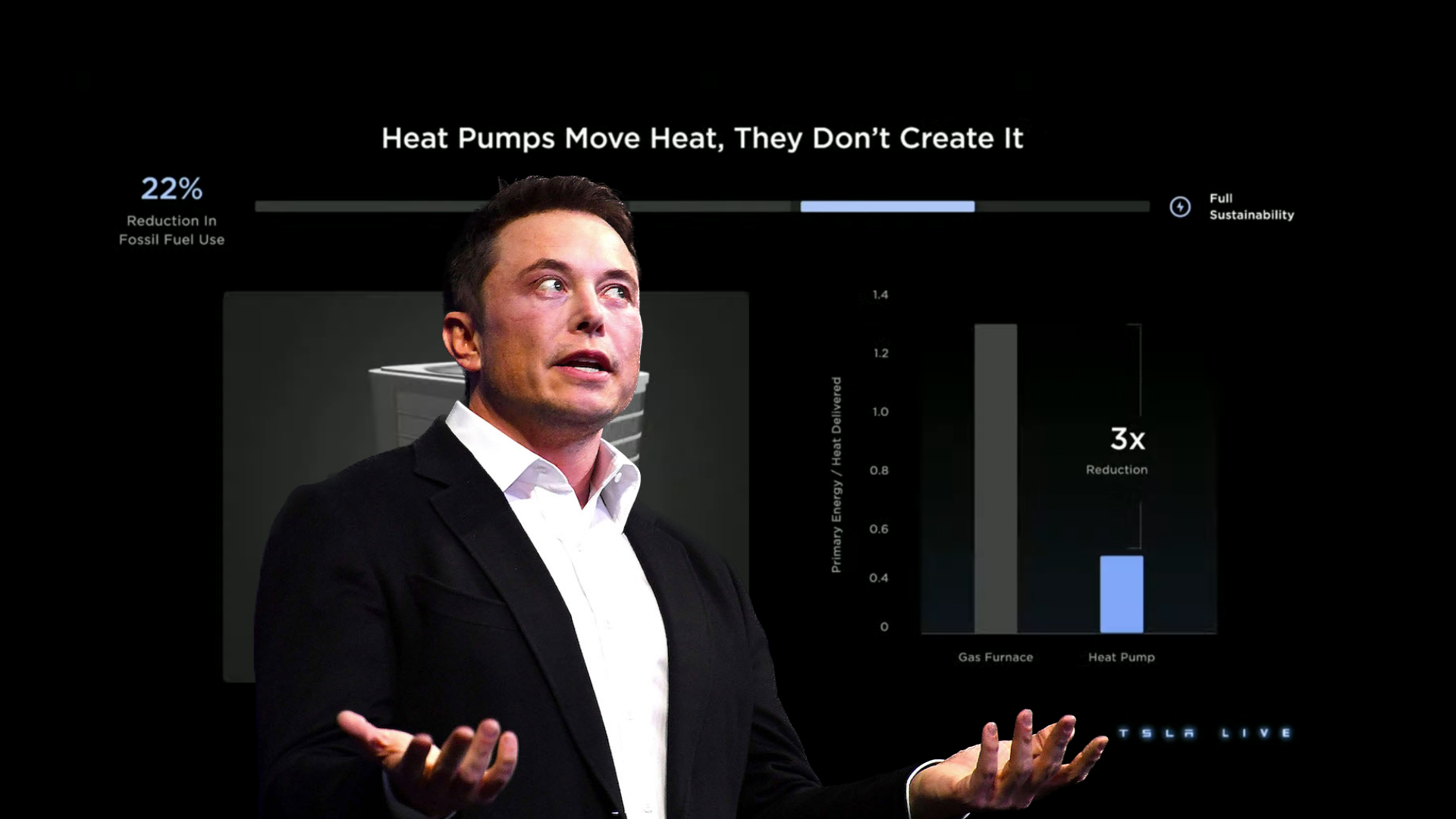
”Demand for our vehicles in terms of desire to own them may as well be infinite — it’s indistinguishable from infinite at this point.”
Talking about “waste heat” that is created by the “combustion economy” is a real and well made point, but the waste of heating and cooling basically all the buildings in the world with current HVAC systems or, for that matter, heat pumps vs. designing buildings with the same rigorous design and efficiency practices lavished on a Tesla vehicle, is a mind-bogglingly huge distinction.
In fact it is “ indistinguishable from infinite”
And don’t even get me started regarding the waste of eschewing distributed, decentralized micro-grids and localized peer generation vs. massively expanding the existing grid, in order to make the same kind of waste: an electrified party of overload rather than a combustion based one…
A polar vortex (or scorching heat wave) is no match for high performance, hyper-efficient design
A recent example of a home built to prove the power of this concept was designed and built in Freeport, Long Island NY by AMBenzing architects. Also known as “Climate House Model C” the All-electric building has a Heating demand: 9.1 kBtu/ft²/yr a Cooling demand: 7.7 kBtu/ft²/yr andTotal source energy: 38 kBtu/ft²/yr, With Air leakage (ACH50): 0.6.
What does that all add up to? A polar vortex cold snap that happened to take place during the measurement period after the home was finished, made for a dramatic illustration of the real world benefits of design and technology, perfectly combined.
The heating energy needed for this extreme weather event was no greater than that needed for normal winter weather, and heating costs were less than $1 per day. The total energy used for heating by the heat pump mini-split system for that day was 5.5 kWh.
The system turned on 11 times and ran overall for two hours and 52 minutes . The total energy used for hot water was 14.3 kWh. The heat pump DHW system turned on 25 times and ran overall for two hours and 57 minutes
Upshot: magnifying the climate benefits of heat pumps is possible by building high-performance homes that are hyper energy-efficient.
Heat pumps are an essential part of modern HVAC systems, used for both heating and cooling homes and businesses. They are more efficient and environmentally friendly than traditional heating and cooling systems, and when paired with high-performance homes, the climate benefits of heat pumps can be increased by a factor of 10 (3x / 30x).
As the world continues to experience the effects of climate change, it’s more important than ever to find ways to reduce our carbon footprint.
By building high-performance homes that are hyper energy-efficient, we can significantly reduce our impact on the environment while maximizing the climate benefits of heat pumps. So wake up, Elon, and smell the abundance.

